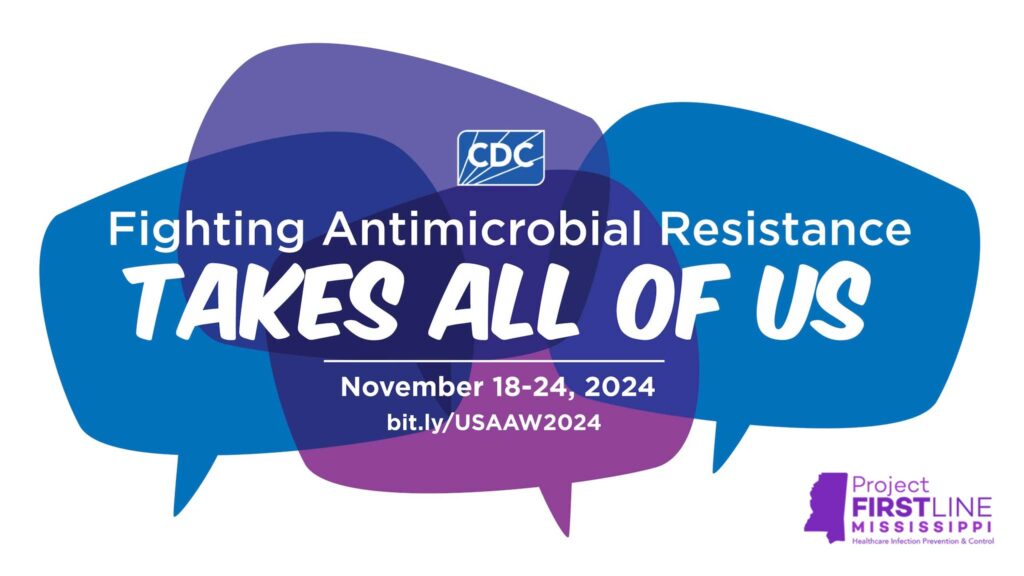
U.S. Antibiotic Awareness Week (USAAW) is observed each year from November 18-24 to raise awareness of the importance of appropriate antibiotic and antifungal use and the threat of antimicrobial resistance (AMR). Antimicrobial resistance occurs when germs like bacteria and fungi resist treatment, allowing them to survive and cause difficult-to-treat infections, contributing to 1.27 million deaths globally each year, including nearly 35,000 in the U.S. these resistant germs can spread rapidly in healthcare settings, communities, and through our food supply. Preventing these infections in the first place is key to improving antibiotic and antifungal use and protecting vulnerable populations from antimicrobial resistance. CDC’s theme for USAAW 2024 is “Fighting Antimicrobial Resistance Takes All of Us,” emphasizing a One Health approach that connects human, animal, plant, and environmental health. Together, we must improve global antibiotic and antifungal prescribing and use while investing in infection prevention across all these areas.
Daily Themes and Key Messages
November 18: Fighting antimicrobial resistance takes all of us
- Everyone plays a role in combating antimicrobial resistance. By adopting a One Health approach, we can enhance antibiotic and antifungal use globally and invest in infection prevention across human, animal, and environmental health (for example soil and water). Learn about actions you can take to fight antimicrobial resistance.
November 19: The global threat of antimicrobial resistance
- Antimicrobial resistance is a global challenge that has been identified in all regions of the world, capable of spreading quickly from one area to another. The extent of resistance, infection rates, healthcare resources, and access to clean water and vaccinations vary significantly across the globe. Read how CDC is helping countries around the world improve their abilities to detect and combat antimicrobial resistant in healthcare settings.
November 20: Human health & antimicrobial resistance
- Any time antibiotics or antifungals are used, they can cause side effects and contribute to the development of antimicrobial resistance. Many medical advances, such as joint replacements, organ transplants, and cancer therapies, rely on effective antibiotic treatment. If these drugs lose effectiveness, our ability to manage infections and related health issues may become compromised.
- Individuals, parents, and caregivers, learn more about antibiotic do’s and don’ts.
- Healthcare providers, find resources for patient education on antibiotic use.
November 21: Animal health & antimicrobial resistance
- Animals carry germs in their gut, including antimicrobial-resistant germs. These germs can spread between animals and in their environments – farms, in animal markets, during transport and processing – and then to people. It’s important to protect the health of animals and the people who work with them, the community, and our food supply. Learn more about the specific infection prevention actions livestock and poultry producers can take to fight antimicrobial resistance.
November 22: Antimicrobial resistance in agriculture and the environment
- Antibiotics and antifungals are sometimes applied as pesticides to manage plant and crop diseases. However, using antibiotics and fungicides in agriculture can contribute to the development and spread of antimicrobial resistance in the environment, in humans, and in animals. Learn how antimicrobial resistance can spread through the environment and in agriculture
November 23: One Health approach to antimicrobial resistance
- Antimicrobial resistance is a One Health issue impacting the health of humans, animals, and the environment. The One Health approach emphasizes the interconnectedness of human health, animal health, and our shared environment. By improving antibiotic and antifungal prescribing and taking preventive measures to stop infections, we can collectively reduce the global spread of antimicrobial resistance.
November 24: Continuing the fight against antimicrobial resistance
- CDC is at the forefront of combating antimicrobial resistance, investing in systems to detect, respond to, and prevent resistant infections in healthcare, communities, the food supply, and the environment to safeguard public health.
- Fighting antimicrobial resistance takes all of us and everyone can play a role. Find out what actions you can take to fight antimicrobial resistance.
Partner organizations—such as federal agencies, health departments, and community groups—are essential to USAAW’s success and awareness efforts. The CDC’s USAAW Toolkit offers resources for engaging in the theme-focused discussions.
How to Participate
- Go Purple for USAAW: Wear purple, bring purple to social media, and encourage organizations to light buildings in purple to raise awareness throughout the week.
- Engage on social media: Follow and interact with CDC, Mississippi State Department of Health (MSDH), and Project Firstline Mississippi on X (formerly Twitter), Facebook, and Instagram.
- Promote resources: Share information about antibiotic stewardship and AMR.
- Learn more: Tune in to webinars and podcasts schedule throughout USAAW.
Project Firstline Mississippi is proud to observe USAAW 2024 and raise awareness of antimicrobial resistance and responsible use of antibiotics and antifungals. Together, we can make a lasting impact during USAAW and beyond!

